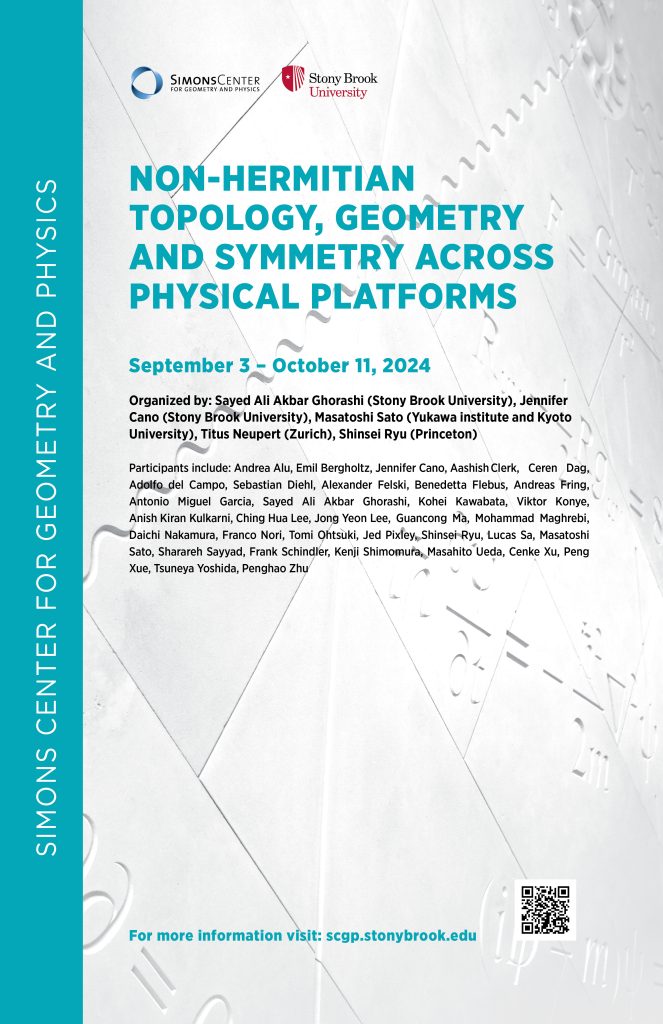Participant ListView Videos
Organizing by:
• Sayed Ali Akbar Ghorashi (Stony Brook University)
• Jennifer Cano (Stony Brook University)
• Masatoshi Sato (Yukawa institute and Kyoto University)
• Titus Neupert (Zurich)
• Shinsei Ryu (Princeton)
Over the last few years there has been a new resurrection of non-Hermitian physics across various fields in both classical and quantum physics, ranging from condensed matter, atomic and photonic systems, soft matter and stochastic models to high-energy and quantum field theories. One of the recent major developments in this area revolves around the topological and symmetry protected phase. It has been shown that many notions such the concept of the gap, nature of gapless structures and bulk boundary correspondence vary drastically from the Hermitian topological phases. Despite the developments in all these directions, a unified understanding of the interplay between these emergent notions is lacking.
Despite these developments, which stimulated much interest in both theoretical and experimental directions, there has been a lack of organized programs that bring experts in all related areas to generate a coherent community. In this program we plan to bring together experts from various backgrounds to ignite dialogues and collaborations across disciplines in order to address the following aspects of novel non-Hermitian topological phases:
Theme 1: A complete understanding of the anomalous nature of the bulk-boundary correspondence, often referred to as the “non-Hermitian skin effect” is still lacking. Particularly, is there a general topological explanation for all skin-effects? How much does topology dictate its presence or absence? What is the role of geometry of the underlying lattice model? Does the presence or absence of specific symmetries teach us anything about it?
Theme 2: In the realm of Hermitian physics, symmetries play an essential role. For example, symmetry can dictate the topological character of bands which led to the theory of topological quantum chemistry. What is the role of symmetry and its interplay with topology in non-Hermitian systems? And to what extent the symmetry indicator formalisms can be applied to non-Hermitian systems ?
Theme 3: Beyond the effective Hamiltonian formalism, a truly open quantum system is described via a Lindblad quantum master equation. However, the two approaches are not always consistent nor have the same power. What are the possible reconciliations?
Theme 4: Recent attempts in non-Hermitian random matrix theory and critical phenomena call for a better understanding of how disorder, interaction and more generally correlation can affect non-Hermitian physics?
Theme 5: The effective field theory of non-Hermitian systems exposes the subtle interplay between non-Hermiticity, topology, geometry and symmetry. For example, it is known that non-Hermitian systems are very sensitive to the boundary conditions of the model. What field theoretical formulation can capture various boundary phenomena such as the skin-effect?
This program and its accompanying workshop will bring together experts from theoretical (mostly) and experimental communities to understand various fundamental and practical issues related to the role of topology, geometry and symmetry in non-Hermitian physics. Our goal is to address the topics above and catalyze interdisciplinary collaborations.
This program will also be hosting a workshop: Non-Hermitian topology, geometry and symmetry across physical platforms: September 23-27, 2024
WEEK 1: September 3 – 6, 2024
Wednesday 9/4/24: 10:30AM – Seminar Room – 313
Speaker: Masatoshi Sato
Title: Non-Hermitian topological phases (lecture 1)
Friday 9/6/24: 10:30AM – Seminar Room – 313
Speaker: Frank Schindler
Title: Making sense of the non-Hermitian bulk-boundary correspondence
WEEK 2: September 9 – 13, 2024
Monday 9/9/24: 2:00PM – Seminar Room – 313
Speaker: Tomi Ohtsuki
Title: Localization-delocalization transitions in disordered Hermitian and non-Hermitian systems
Wednesday 9/11/24: 10:00AM – Seminar Room – 313
Speaker: Cenke Xu
Title: The “Choi-Spin Liquids” in Steady States
Wednesday 9/11/24: 11:00AM – Seminar Room – 313
Speaker: Antonio Miguel Garcia-Garcia
Title: The Sachdev-Ye Kitaev model: from quantum gravity to non-hermitian topology
Friday 9/6/24: 10:00AM – Seminar Room – 313
Speaker: Masatoshi Sato
Title: Non-Hermitian topological phases (lecture 2)
WEEK 3: September 16 – 20, 2024
Monday 9/16/24 2:00PM – Seminar Room – 313
Speaker: Guancong Ma
Title: Non-Hermitian Experiments with Acoustic and Mechanical Waves
Wednesday 9/18/24 10:00AM – Seminar Room – 313
Speaker: Lucas Sa
Title: Emergent Non-Hermitian Topology in Dissipative Quantum Chaos
Wednesday 9/18/24 11:00AM – Seminar Room – 313
Speaker: Andreas Fring
Title: Mending the Spontaneously Broken PT-Regime
Friday 9/20/24 10:00AM – Seminar Room – 313
Speaker: Jong Yeon Lee
Title: Open Quantum Dynamics and Spontaneous Symmetry Breaking
Friday 9/20/24 11:00AM – Seminar Room – 313
Speaker: Kohei Kawabata
Title: Non-Hermitian Topology in Hermitian Topological Matter: Wannier Localizability and Detachable Topological Boundary States
WEEK 4: September 23 – 27, 2024
Workshop: Non-Hermitian topology, geometry and symmetry across physical platforms
WEEK 5: September 30 – October 4, 2024
Wednesday 10/2/24: 10:00AM – Seminar Room – 313
Speaker: Sebastiean Diehl
Title: Universal phenomena of broken time translation symmetry
Friday 10/4/24 10:00AM – Seminar Room – 313
Speaker: Discussion (led by Masahito Ueda)
Title: Where and how to look for non-Hermitian physics in condensed matter platforms?
WEEK 6: October 7-11, 2024
Monday 10/7/24 2:00PM – Seminar Room – 313
Speaker: Viktor Konye
Title: Non-Hermitian topology of transport
Monday 10/7/24 2:45PM – Seminar Room – 313
Speaker: Anish Kulkarni
Title: Internal symmetry and dynamical phenomena in open quantum systems
Wednesday 10/9/24: 10:00AM – Seminar Room – 313
Speaker: Andrea Alu
Title: Non-Hermitian phenomena with complex frequency excitations


